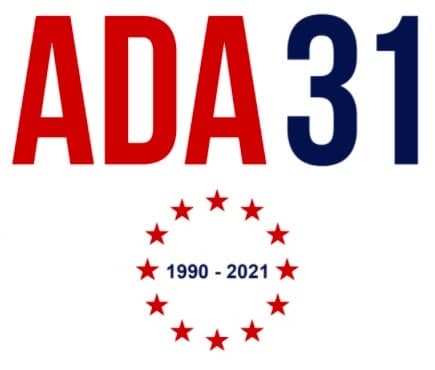Today (July 26) marks the 31st anniversary of the Americans with Disabilities Act (ADA), the first comprehensive civil rights legislation addressing and granting basic accessibility needs for people with disabilities.
The act dramatically changed – and improved – the social and political landscape of the United States, and greatly advanced the rights of people with disabilities. In fact, it’s hard to imagine that some of the rights and benefits that we now take for granted didn’t exist or were difficult to come by just three decades ago.
Among other things, the ADA ensures fair employment practices and equal access to jobs, physical access to all public and many private spaces, accessible communications, adequate housing, and accessible public transportation.
 Without the ADA, even something as simple as curb cuts at street crossings and ramps at entryways for wheelchair users might not exist. And, now, because of it, individuals of all abilities benefit from them, whether they’re pushing strollers or carts or have difficulty navigating steps.
Without the ADA, even something as simple as curb cuts at street crossings and ramps at entryways for wheelchair users might not exist. And, now, because of it, individuals of all abilities benefit from them, whether they’re pushing strollers or carts or have difficulty navigating steps.
The same holds true with captions. While the ADA didn’t specifically address captioning for television, the law helped shine a light on the need for communications accessibility and telecommunications equality. As a result, millions of Americans now benefit from closed captioning in addition to those who rely on it, including early readers, English Language Learners (ELL), and anyone trying to watch television or videos in a noisy environment.
For the deaf and hard-of-hearing community, the few laws in place prior to the passage of the Americans with Disabilities Act were limited in scope and required equal communication access mainly for entities that received federal funding. The ADA went a long way to expanding the number and types of places that are required to provide accessible communications, whether it be through captioning, assistive listening systems and devices, sign language interpretation, telephone handset amplifiers, text telephones, or simple written materials.
Captioning Rules Move Forward
Captioning rules and regulations have expanded over the years, reinforcing the need and absolute right of equal access to television for deaf and hard of hearing viewers. Below are just a few of the milestones in the captioning industry realized after the passage of the ADA.
- 1990 – The Television Decoder Circuitry Act mandated that all televisions 13 inches or larger manufactured for sale in the United States contain caption decoders.
- 1996 – The Telecommunications Act of 1996 required that digital television receivers contain caption-decoding technology, and set forth benchmarks that would promulgate the use of captioning.
- 2010 – The 21st Century Communications and Video Accessibility Act required, among other things, that video programming that is closed captioned on TV also be captioned when distributed on the Internet.
- 2012 – A settlement in National Association of the Deaf (NAD) v. Netflix would provide increased access to movies and television streamed on the Internet for people who are deaf and hard of hearing. The lawsuit charged the entertainment giant with violating the ADA by failing to provide closed captioning for most of its content.
- 2015 – Resolving concerns from deaf and hard-of-hearing communities to improve captioning quality, the Federal Communications Commission (FCC) put in place a series of Caption Quality Best Practices, which included rules for accuracy, synchronicity, completeness, and placement of captions.
- 2016 – Online video clips are required to be closed captioned if any portion of the clip appeared captioned on television or via IP at any time. A similar rule went into effect one year later that required montage video clips to be closed captioned from any prerecorded programming captioned on television or via IP.
VITAC is proud to support the Americans with Disabilities Act’s 31st anniversary.




